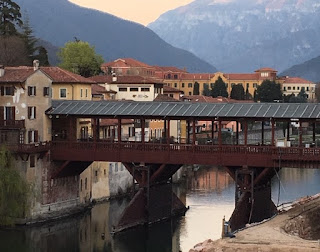Take a day trip to this gem of the northern Veneto
 |
| The Ponte Vecchio - or Ponte degli Alpini - was originally built by Andrea Palladio in 1568 |
Bassano is in the foothills of the Alps and there are stunning mountain views from many of its street corners.
The town’s most famous landmark is the covered wooden bridge designed by Andrea Palladio in 1568 that still spans the Brenta River. It was badly damaged at the end of World War II by the retreating German army and lovingly rebuilt and restored by the town’s Alpini, a contingent of Italy’s prestigious alpine troops.
Bassano has become famous for producing the eponymous alcoholic drink, Grappa, which is enjoyed by Italians as a digestivo or liqueur. The drink derives its name from the graspa, or remnants, of the grapes that are left over after wine making, while the town is named after Monte Grappa, a mountain of the Venetian Prealps.
 |
| The huge Torre Civica towers over Piazza Garibaldi, one of Bassano's central squares |
The Museo degli Alpini, at the end of the bridge nearest the historic centre of the town, was founded with just a few items in 1948 after the first post-war national assembly of the Alpini, but it has grown over the years, as objects from both world wars have been donated.
Once you have crossed the bridge you will soon see the Torre Civica, 43m (141ft) tall, which was once a lookout tower inside the 12th century walls, but now serves as a clock tower.
In Piazza Garibaldi, one of the biggest squares, is the 14th century Church of San Francesco, which has a tranquil cloister housing the Museo Civica, the town’s museum. The museum has the biggest collection of works by local artist Jacopo dal Ponte, who was also known as Jacopo Bassano.
In the adjoining square, Piazza Libertà, there is a 17th century sculpture of San Bassiano, the town’s patron saint, and a market is held there every Thursday.
 |
| The Viale dei Martiri serves as a poignant memorial to 31 partisans executed there in 1944 |
Nearby, the beautiful, peaceful Viale dei Martiri has lovely mountain views and provides a poignant memorial to 31 young partisans who were executed there by the Germans in September 1944.
Many were hung from the trees that line the road and today each tree bears the name of the soldier who was murdered there and many display a photograph of the young victim. The road, formerly, Viale XX Settembre, was renamed in their honour.
Should you wish to stay longer in Bassano del Grappa, the pleasant Hotel Victoria is recommended. Situated in Viale Armando Diaz, just a short walk from the historic centre, the Victoria has friendly, welcoming staff and all the facilities you would expect from a traditional Italian hotel.
Home